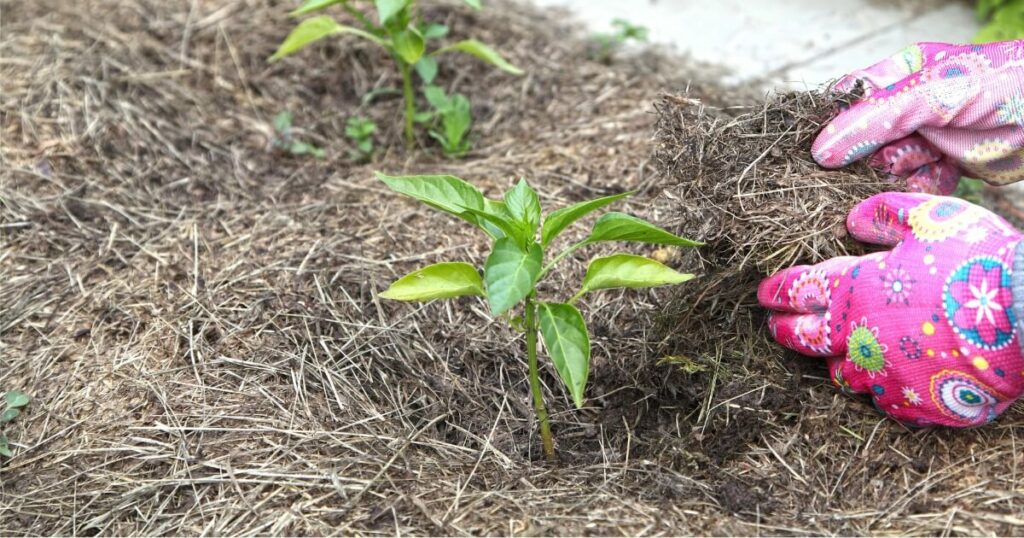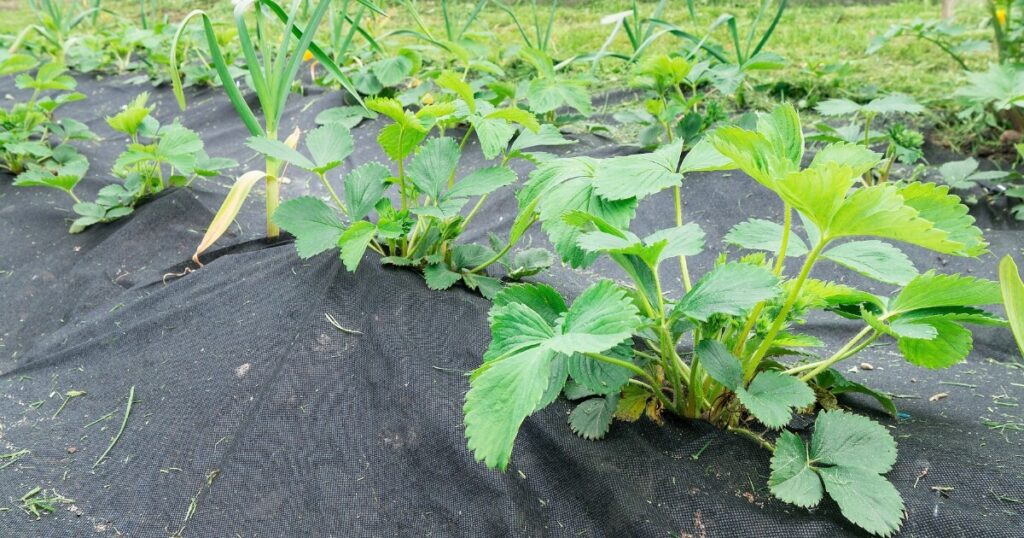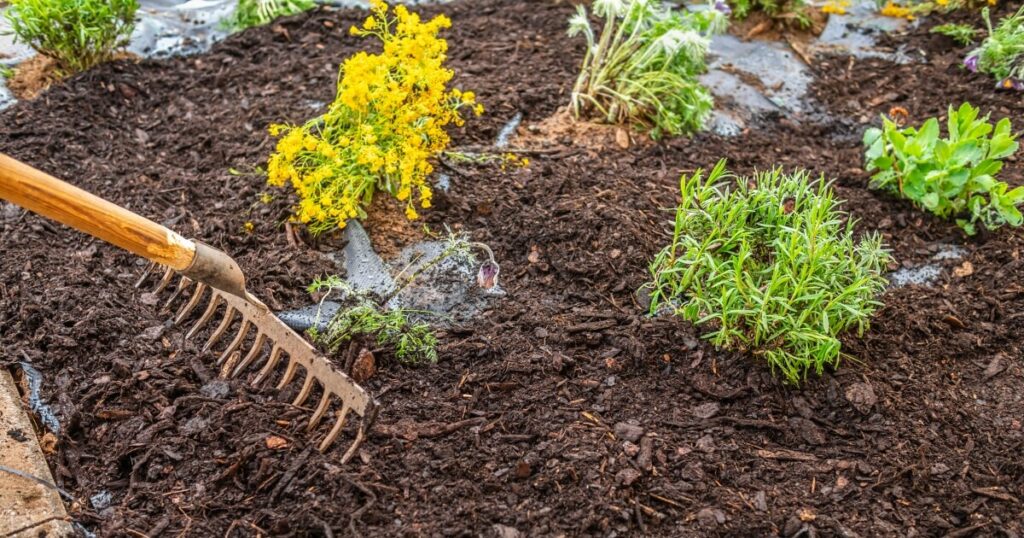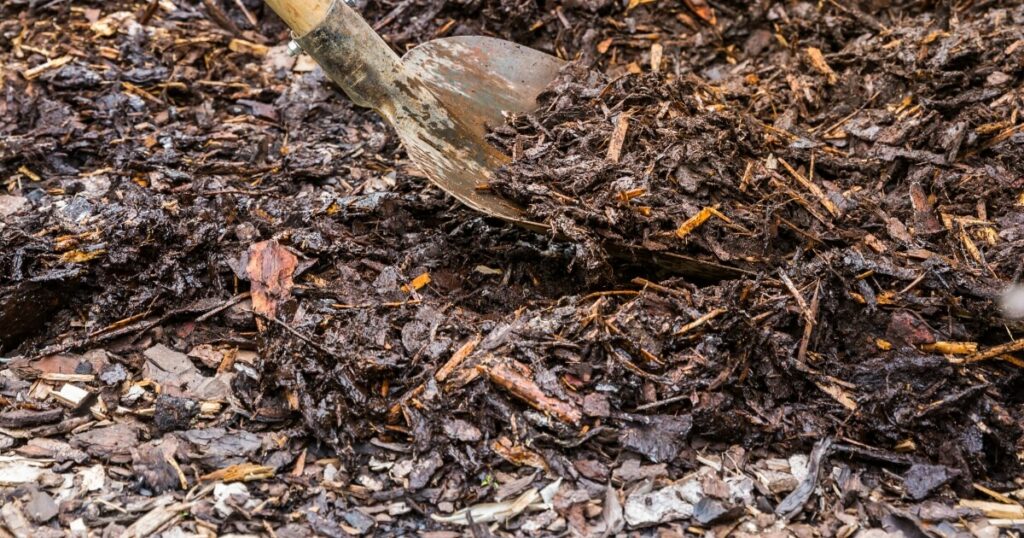Using mulch can save you time on watering, protect your plants, and add curb appeal to your yard and garden.

In this guide, I’ll explain everything you need to know about mulching as a beginner. You’ll learn not just how to choose the right mulch for your garden but also practical advice on how to apply it effectively so that your plants thrive and your garden or landscaping efforts become the envy of the neighborhood.
Types Of Mulch
When you stroll down the garden center aisles, you’ll notice mulch comes in various forms. Choosing the right one can feel like selecting the perfect topping for your ice cream, and it depends on what you’re craving!
Let’s break down the two main categories: organic and inorganic mulches.
Organic Mulches
These mulches are made from natural materials that decompose over time.
PROS
- Improve soil fertility as they break down
- Encourage beneficial microorganisms and earthworms
- Provide insulation, keeping soil cooler in summer and warmer in winter
CONS
- May harbor pests if not properly composted
- Can deplete nitrogen from your soil as they decompose (counter this by adding a nitrogen-rich fertilizer)
- Need replenishing as they break down over time
Some popular choices include:

- Bark: Comes in various sizes and is great for those looking for durability.
- Straw: A favorite for vegetable gardens, straw is lightweight and easy to spread.
- Wood Chips: Ideal for pathways and around trees, wood chips have a rustic charm.
Inorganic Mulches
Inorganic mulches are the long-lasting cousins in the mulch family. They don’t break down like organic options but still offer some perks.
PROS
- Don’t need replacing often
- Prevent weed growth effectively
- Stay put better than organic options in windy areas
CONS
- Don’t improve soil health since they don’t decompose
- It can become too hot, potentially harming plant roots
- It might be less environmentally friendly due to its manufacturing process

Here’s a peek at a few:
- Stones: Add an elegant touch to your landscape but can increase soil temperature.
- Rubber: Made from recycled tires and is cushy underfoot and comes in fun colors.
- Landscape Fabric: Suppresses weeds while allowing water and air to pass through.
Whether you lean towards organic coziness or the steadfastness of inorganic types, remember that each garden has its own needs. Consider your plants’ preferences, local climate conditions, and how much time you’re willing to spend on maintenance when choosing your mulch match.
Benefits Of Mulching
Mulching is a multi-tool that tackles several gardening challenges all at once.
Whether you’re looking to save water, protect your plants from temperature swings, or just make your garden beds look snazzy, reaching for mulch is a smart move.
Here are some standout benefits that’ll have you mulching in no time.
Weed Suppression
Think of mulch as your garden’s personal bodyguard against weeds. It forms a barrier that makes it tough for those uninvited plants to take root. By blocking sunlight, mulch keeps weed seeds in the dark, reducing their energy production and preventing them from sprouting.
Soil Moisture Retention
If you’re tired of watering your plants every time the sun decides to turn up the heat, mulch is your new best friend. It can act like a sponge and hold onto moisture, slowly releasing it over time. This means less frequent watering and happier plants.
Temperature Regulation
Mulch is pretty good at playing thermostat, too. During those scorching summer days, it keeps the soil cool and comfy for plant roots. When winter rolls around, it tucks them in with an insulating layer that fends off the cold.
Erosion Control
Soil erosion can sweep away your hard work with rain or wind faster than you can say “gardening gloves.” Mulch steps in as a shield, reducing the impact of heavy rain and keeping your precious soil right where it belongs.
This is essential for the health of your slope’s vegetation and the overall integrity of your landscape. Slopes become more manageable and visually pleasing, transforming a potential gardening headache into a beautiful, stable part of your outdoor space.
Soil Fertility Improvement
Organic mulches are like vitamins for your soil that break down and feed it with nutrients. This natural boost encourages worms and other beneficial critters to move in and work their magic, making for robust soil that supports strong plant growth.
How To Choose The Right Mulch
When selecting the right mulch for your garden, you want something that looks good and considers your plants’ needs.

Note: Mulch can and will fade over time.
Here’s how to make the perfect choice.
Consider Your Plants’ Needs
Just as you wouldn’t wear flip-flops in a snowstorm, you wouldn’t choose a mulch that doesn’t suit your plants. Some questions to ask yourself:
- Does the plant prefer acidic soil? If so, pine needles might be your go-to as they can help lower soil pH over time.
- Are you mulching a vegetable garden? Straw could be your best bet since it’s easy to rearrange as you rotate crops. Avoid synthetics like rubber mulch that may leech chemicals into your soil and into your crops.
- Looking for pest control? Cedar bark has natural oils that can deter bugs.
Evaluate Local Climate and Soil Type
Your local weather and soil play critical roles in determining which mulch works best:
- In hot climates, lighter-colored mulches reflect sunlight and keep the soil cooler.
- In cooler regions, darker mulches absorb heat during the day and warm the soil at night.
- For clay soils, finer mulches can help improve structure and drainage.
- Sandy soils benefit from heavier mulches that prevent nutrients from washing away too quickly.
Balance Aesthetics with Functionality
We all want our gardens to be head-turners. However, always weigh these choices against their functional impact on plant health and maintenance requirements.
While colored rubber mulch might catch your eye with its vibrant hues, consider whether it will provide the benefits your garden truly needs.
If you’re after curb appeal:
- Decorative bark gives a polished look and works well in flower beds or around shrubs.
- River rocks or pebbles add an element of sophistication and are great for succulent gardens or pathways.
Proper Mulching Techniques
How to Apply Mulch in Gardens
Applying mulch is like tucking your plants into bed, so you want to do it just right.

Here’s the lowdown on how to mulch your garden properly:
- Depth and Spread Recommendations: A 2-3 inch layer of mulch is generally sufficient. Any thicker, and you might suffocate your plants. Any thinner won’t be effective against weeds or moisture retention.
- Around Trees and Shrubs: Think donut, not volcano. Keep mulch away from the base of trunks to prevent rot and disease. Extend the mulch out to the drip line of the branches if possible.
- In Vegetable Gardens and Flower Beds: Spread an even layer between rows or around plants after they’ve been planted. Be careful not to pile mulch against stems or foliage.
How to Apply Mulch in Landscaping
When you’re working with larger areas or designing for curb appeal, here’s what to keep in mind:
- Mulching Large Areas: Use a wheelbarrow and shovel or a mulch blower if available for extensive landscapes. Start from one end and work systematically across the area for even coverage.
- Pathways and Aesthetic Considerations: Wood chips or bark work well for paths as they’re comfortable underfoot and look natural. To boost aesthetics, consider using stone or rubber mulches in areas where you want added color or texture.
Remember that proper technique goes hand in hand with choosing the right type of mulch.
Mulching Dos And Don’ts
Best Practices for Mulching
Here are some tips to ensure you’re on the path to mulching mastery:
- Do Test Soil Beforehand: Check your soil’s pH and nutrient levels to select a mulch that complements its needs.
- Do Maintain Proper Depth: Aim for that sweet spot of 2-3 inches of mulch to avoid air circulation and moisture issues.
- Do Leave Some Breathing Room: Give plants space by keeping mulch a few inches away from stems and tree trunks.
- Do Replenish Organic Mulches Annually: Since they break down over time, topping up organic mulches helps maintain their benefits.
- Do Consider Local Wildlife: If you’re in an area with termites or rodents, steer clear of wood-based mulches close to your home.
Common Mulching Mistakes to Avoid
Even seasoned gardeners can slip up when it comes to mulching. Keep an eye out for these issues:
- Don’t Over-Mulch: Piling on too much can lead to waterlogged soil, root rot, and suffocated plants.
- Don’t Use Fresh Grass Clippings: These can create a mat which prevents water from reaching the soil. If you use grass clippings, let them dry out first.
- Don’t Ignore Weeds: Remove existing weeds before laying down mulch. Otherwise, you might be giving them a hiding spot to thrive.
- Don’t Forget About Pests: Some organic mulches may attract insects, so be mindful of what you choose if pests are a concern in your area.
- Don’t Mix Inorganic Mulches with Soil: They won’t break down and can hinder future planting efforts.
Seasonal Mulching
By aligning your mulching routine with Mother Nature’s calendar, you’ll provide your garden with year-round support. Just remember to adjust your techniques as seasons change for optimal plant health and growth.
When to Mulch During the Year
Timing is everything! Here’s a seasonal breakdown:
- Spring: Add fresh mulch to your beds as temperatures rise and plants start waking up. This helps prevent weeds from sprouting and retains moisture for the growing season ahead.
- Summer: Check the mulch levels and add more if necessary to keep that 2-3-inch layer intact. Summer mulching keeps soil temperatures stable during heat waves.
- Fall: After cleaning up fallen leaves and debris, apply a new layer of mulch. It’ll insulate plant roots against the impending cold and give your garden a tidy appearance.
- Winter: In colder regions, winter mulching after the ground freezes can protect perennials from freeze-thaw cycles that can heave them out of the soil.
Adjusting Mulching Techniques for the Seasons
Each season has its quirks, so tweak your mulching approach accordingly:
- Spring: Go lighter on mulch to let the soil warm up, especially if you’re eager to kickstart your planting.
- Summer: Focus on moisture retention by ensuring coverage is even and consistent without suffocating plants.
- Fall: Consider using leaf mold or straw in vegetable gardens for added insulation and nutrients as they decompose over winter.
- Winter: Apply a thicker layer of mulch for protection against frost, but wait until after the first freeze to avoid attracting rodents seeking warmth.
Mulch Maintenance
Maintaining Mulch in Gardens and Landscapes
Maintaining mulch requires regular check-ins and a bit of touch-up work. This means inspecting your mulch periodically for your gardens and landscapes to ensure it’s doing its job effectively.
- Monitor Mulch Levels: Organic mulches decompose over time, and inorganic ones can be displaced. Every few months, take a stroll through your garden to check the depth and coverage.
- Weed Patrol: Even the best-laid mulch can’t stop all weeds. Pull any that manage to peek through to keep your garden beds clean and tidy.
- Water Wisely: When you water your plants, make sure the moisture is penetrating the mulch layer and reaching the soil. If not, you may need to adjust how you’re applying water.
Replenishing Mulch
Sometimes, your mulch needs a boost to stay effective. So, how often should mulch be replaced?

- Top-Up as Needed: Add more material once or twice a year for organic mulches to maintain that ideal 2″ to 3″ layer.
- Replace Inorganic Mulches Less Often: They last longer but can still get scattered or sink into the soil over time. Refresh these materials as needed to keep areas looking sharp.
Turning and Fluffing Mulch
Mulches can become compacted over time, which isn’t great for air or water flow.
- Give It a Fluff: Use a rake or hand fork to gently stir up the top layer of mulch. This aerates it and prevents it from forming an impenetrable mat.
- Turn It Over: Occasionally turning over organic mulches can expose fresh material to the elements, helping it decompose more evenly.
Dealing with Mold and Fungus
Sometimes, you might spot mold or fungus on your mulch, which is normal but needs attention.
- Remove Offending Areas: Scoop out any moldy or fungal growths along with some of the surrounding mulch.
- Improve Air Circulation: Make sure there’s enough space between plants for air to move freely. This helps prevent moisture buildup that leads to mold.
- Consider Material Change: If mold is persistent, switch to a different type of mulch that may be less prone to fungal issues in your specific garden conditions.
Not sure what to do with old mulch that you’ve removed? Here are things to do with old mulch.
Troubleshooting Mulch Issues
Tackling Pests in Mulched Areas
Mulch can sometimes feel like a welcome mat for pests, but don’t let that deter you. If you’re dealing with critters making themselves at home in your mulch, here’s what to do:
- Identify the Culprits: Different pests require different strategies. Slugs and snails love moist environments, while termites are attracted to wood mulches.
- Set up Barriers: Copper strips can deter slugs, and diatomaceous earth is effective against many crawling pests.
- Choose Pest-Resistant Mulch: Cedar and cypress mulches have natural oils that can repel insects. Consider switching if pests are a recurring issue.
Preventing Rot and Disease
A soggy mulch layer can lead to rot and disease in plants. Here’s how to prevent these issues:
- Ensure Proper Drainage: Make sure your garden beds allow water to drain away efficiently.
- Avoid Overwatering: Too much water plus mulch equals trouble. Water according to your plants’ needs and weather conditions.
- Inspect Plants Regularly: Catching signs of rot or disease early on means you can take action before it spreads.
Managing Improper Moisture Levels
Mulch is meant to help maintain soil moisture, but sometimes it can get out of control. Here’s how to balance things out:
- Check Soil Moisture: Dig down beneath the mulch with your finger to ensure the soil isn’t too dry or too wet. I prefer to check using a soil moisture meter for accuracy.
- Adjust Mulching Material or Depth: Consider a finer-textured organic mulch that retains more moisture if the soil is consistently dry. Conversely, if it’s too wet, reduce the depth of the mulch or opt for a coarser type.
In Summary
In the grand gardening scheme, mulch is one of your plant’s best allies. It suppresses weeds, retains soil moisture, regulates temperature, controls erosion, and improves soil fertility.
Whether you opt for organic mulch with its nurturing qualities or inorganic for its longevity, the right choice can significantly boost your garden’s health and aesthetics.
Don’t hesitate to experiment with different types of mulch until you find the one that works wonders for your green space.